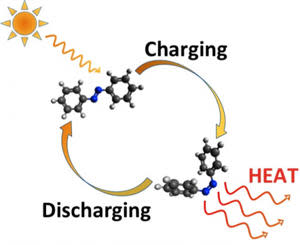 Science and Weather
Science and WeatherResearchers produce amazing new smart, alternative energy sources
Faced with dwindling resources, a polluted environment and a changing climate due to the use of hydrocarbon fuels, as well as resistance to ideas of expanding nuclear and wind power, scientists have been exploring some very interesting ways of generating and storing electricity.
One promising field has been 'energy harvesting,' which woks simply by having the right materials and technologies in place as we go about our daily lives. This can involve clothing, sidewalks and roads made of new piezoelectric materials, that produce electricity as we move, walk along, or drive our vehicles, or it can put technologies to use that are already ubiquitous in our modern households.
South Korean scientists have come up with a way of using dielectric materials to convert the movement of water into electricity. This can be incorporated into roofs to harness electricity from rain, or it could be used in toilets to produce electricity anytime anyone flushes. Here's some demonstrations of the proof-of-concept, which used the water in contact with the materials in various ways, generating enough electricity to light up a small green LED:
That isn't very much electricity, but this is very small scale. Upsize this from the 30 microlitres used in the experiments to litres of rain flowing over a roof, or water swirling down the toilet bowls of millions of households, and it starts to add up.
Working on a similar principle, but going perhaps a bit more high-tech and a lot more small-scale with it, Chinese researchers have produced an electric current by sliding drops of sea water over a sheet of graphene — a one-atom thick layer of carbon atoms that's laid out in a honeycomb pattern. According to the research, if the sea water just sits still on the graphene surface, nothing happens. However, as soon as the drop moves, the dissolved ions of sodium and chlorine in it get separated, and it sets up a very basic electric circuit where electrons are taken up from the graphene at one end of the drop and then flow back into the graphene at the other end of the drop. This produces a measurable voltage of a few millivolts. Scaling it up slightly and using copper chloride instead of seawater, just letting the drop slide by the force of gravity generated around 30 millivolts. That's still a fairly small amount, but this isn't about replacing hydroelectric power stations. The boon here is that this could produce miniature hydroelectric power generators for smaller applications.
Going even smaller still, a team of researchers at Harvard University and MIT have found a way to store solar energy in molecules indefinitely, and then release that energy in the form of heat at any time later just by exposing those molecules to light, heat or electricity. The key for this is using what are called photoswitchable molecules, specifically a chemical called azobenzene, which are attached to long carbon nanotubes so that the entire structure looks a bit like a comb, according to MIT News.
Each molecule absorbs energy from sunlight, which flips the molecule into a higher energy state that it can maintain indefinitely, and the closer the azobenzene molecules are packed onto the carbon nanotubes, the more energy that can be stored. The research team figured on a 30 per cent increase in energy storage, over what a single molecule could store. However, the real breakthrough came from discovering that when the comb-like structure of the two molecule-nanotube structures became interlocked with each other, this reduced the spacing between the molecules even more than expected, giving them an energy storage increase of over 200 per cent.
This won't solve all the problems that currently face us with solar power, but it will definitely make the technology more flexible and the energy more portable — basically creating a rechargeable solar battery.
"It could change the game, since it makes the sun's energy, in the form of heat, storable and distributable," said Jeffrey Grossman, a co-author of the research paper and an associate professor of materials science and engineering at MIT, according to the MIT News statement.
[ More Geekquinox: Rising flood waters force evacuations in Quebec, states of emergency in Ontario ]
Now that we're into the 21st century, one of the things that humanity needs to work on is getting ourselves away from burning things for heat and power. Even nuclear power is basically about heating up steam to drive turbines, but just using the heat from nuclear fission to do it. We've been going about this the same way for thousands of years now, just making more sophisticated methods of producing the heat, but it's time to move on.
It's ideas like the ones above, and the various other energy harvesting projects, that will produce electricity without any of the middle steps, and without resorting to millenniums-old methods to do it. That's not only going to be good for the health of the planet, but it'll also be good for our development to leave those methods behind as we move into the future.
(Images courtesy: Wikimedia Commons, Harvard/MIT)
Geek out with the latest in science and weather.
Follow @ygeekquinox on Twitter!





